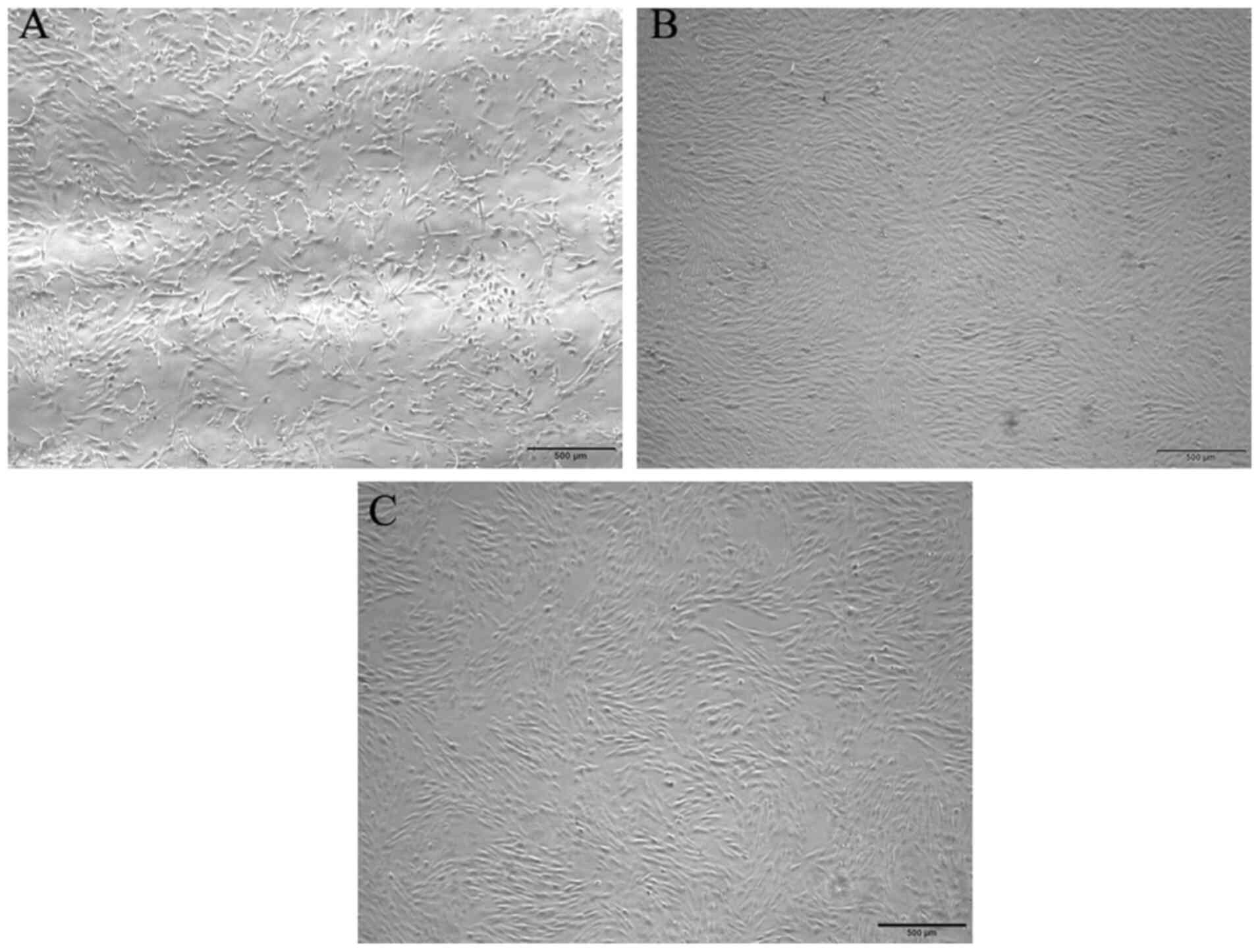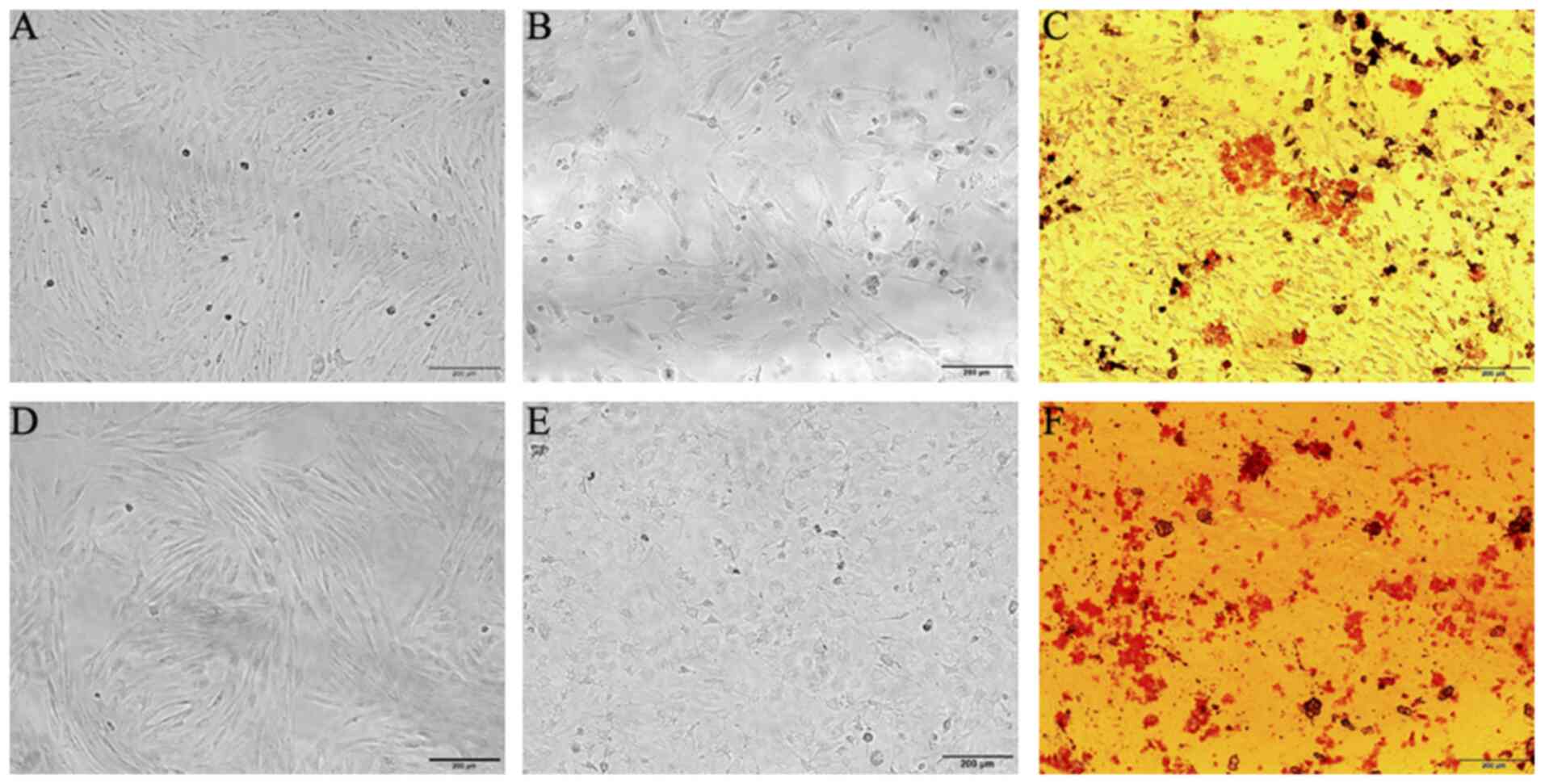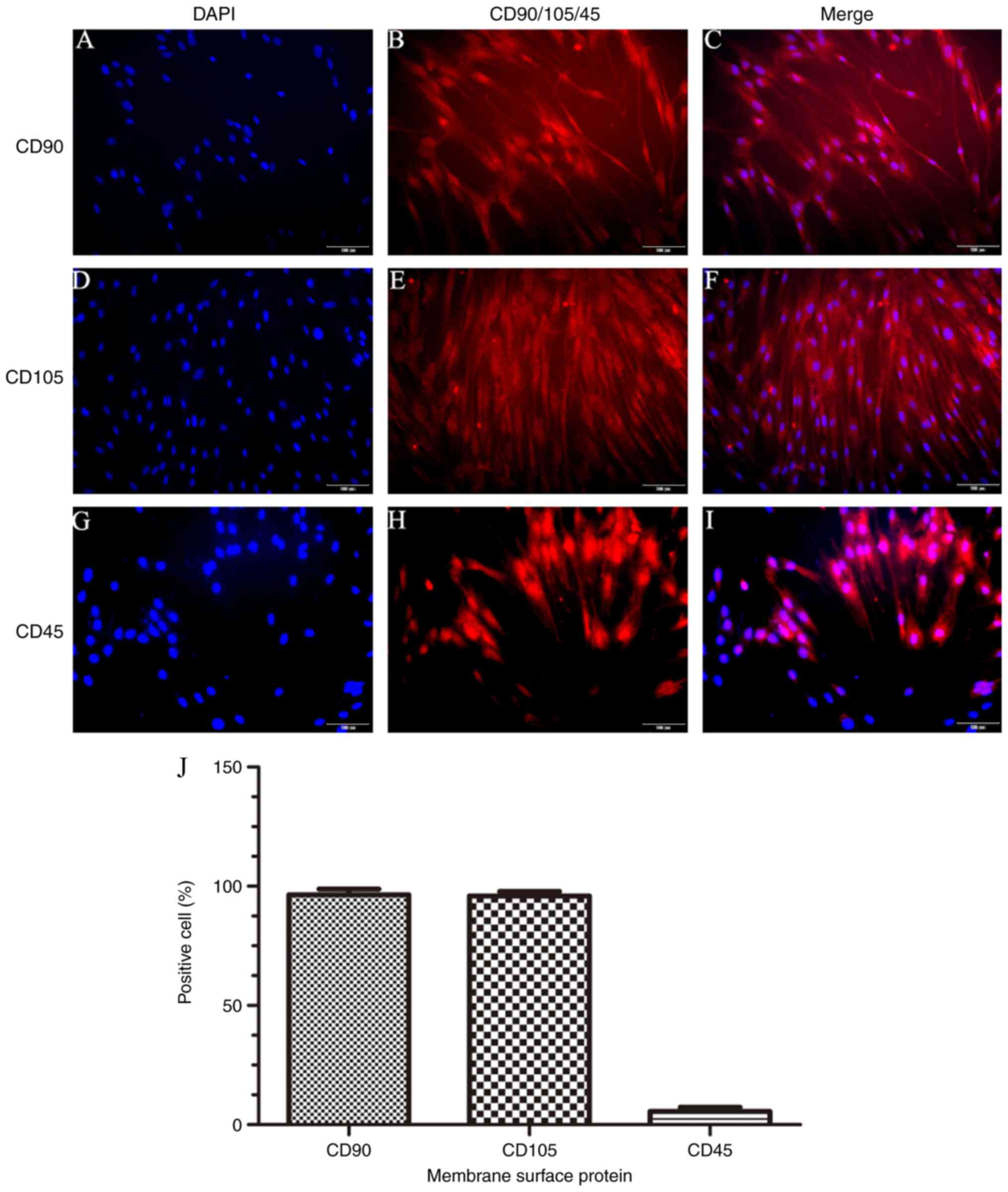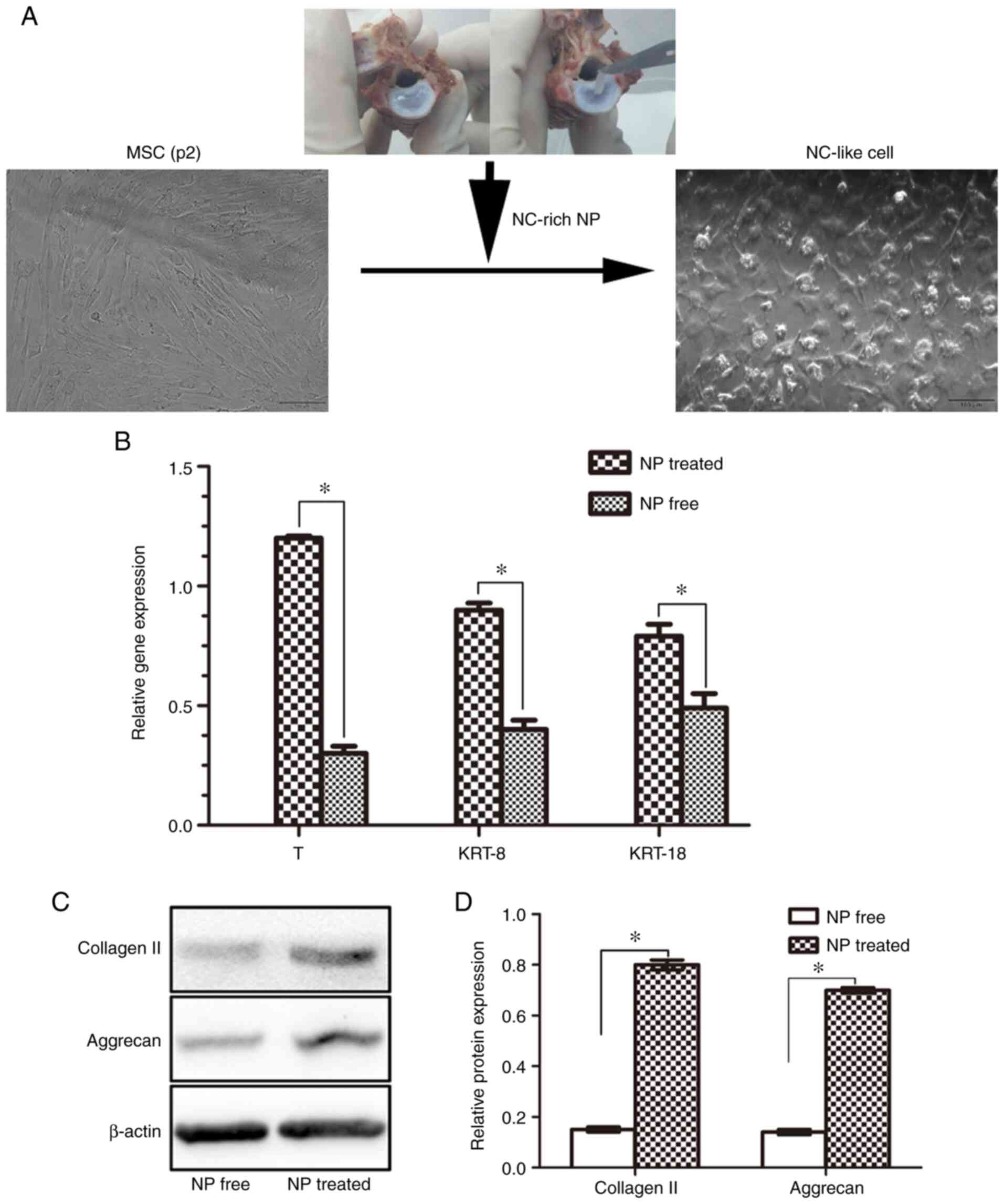|
1
|
Hoy D, March L, Woolf A, Blyth F, Brooks
P, Smith E, Vos T, Barendregt J, Blore J, Murray C, et al: The
global burden of low back pain: Estimates from the global burden of
disease 2010 study. Ann Rheum Dis. 73:968–974. 2014. View Article : Google Scholar : PubMed/NCBI
|
|
2
|
Lee EH and Hui JH: The potential of stem
cells in orthopaedic surgery. J Bone Joint Surg Br. 88:841–851.
2006. View Article : Google Scholar : PubMed/NCBI
|
|
3
|
Luo J, Wang H, Peng J, Deng Z, Zhang Z,
Liu S, Wang D, Gong M and Tang S: Rate of adjacent segment
degeneration of cervical disc arthroplasty versus fusion
meta-analysis of randomized controlled trials. World Neurosurg.
113:225–231. 2018. View Article : Google Scholar : PubMed/NCBI
|
|
4
|
Wu TK, Meng Y, Wang BY, Hong Y, Rong X,
Ding C, Chen H and Liu H: Is the behavior of disc replacement
adjacent to fusion affected by the location of the fused level in
hybrid surgery? Spine J. 18:2171–2180. 2018. View Article : Google Scholar : PubMed/NCBI
|
|
5
|
Johannessen W and Elliott DM: Effects of
degeneration on the biphasic material properties of human nucleus
pulposus in confined compression. Spine (Phila Pa 1976).
30:E724–E729. 2005. View Article : Google Scholar : PubMed/NCBI
|
|
6
|
Li XC, Wu YH, Bai XD, Ji W, Guo ZM, Wang
CF, He Q and Ruan DK: BMP7-based functionalized self-assembling
peptides protect nucleus pulposus-derived stem cells from apoptosis
in vitro. Tissue Eng Part A. 22:1218–1228. 2016. View Article : Google Scholar : PubMed/NCBI
|
|
7
|
Crevensten G, Walsh AJ, Ananthakrishnan D,
Page P, Wahba GM, Lotz JC and Berven S: Intervertebral disc cell
therapy for regeneration: Mesenchymal stem cell implantation in rat
intervertebral discs. Ann Biomed Eng. 32:430–434. 2004. View Article : Google Scholar : PubMed/NCBI
|
|
8
|
Berebichez-Fridman R, Gómez-García R,
Granados-Montiel J, Berebichez-Fastlicht E, Olivos-Meza A, Granados
J, Velasquillo C and Ibarra C: The Holy Grail of orthopedic
surgery: Mesenchymal stem cells-their current uses and potential
applications. Stem Cells Int. 2017:26383052017. View Article : Google Scholar : PubMed/NCBI
|
|
9
|
Prockop DJ: Marrow stromal cells as stem
cells for nonhematopoietic tissues. Science. 276:71–74. 1997.
View Article : Google Scholar : PubMed/NCBI
|
|
10
|
Vadalà G, Russo F, Ambrosio L, Loppini M
and Denaro V: Stem cells sources for intervertebral disc
regeneration. World J Stem Cells. 8:185–201. 2016. View Article : Google Scholar : PubMed/NCBI
|
|
11
|
Steffen F, Smolders LA, Roentgen AM,
Bertolo A and Stoyanov J: Bone marrow-derived mesenchymal stem
cells as autologous therapy in dogs with naturally occurring
intervertebral disc disease: Feasibility, safety, and preliminary
results. Tissue Eng Part C Methods. 23:643–651. 2017. View Article : Google Scholar : PubMed/NCBI
|
|
12
|
Marcucio RS, Nauth A, Giannoudis PV,
Bahney C, Piuzzi NS, Muschler G and Miclau T III: Stem cell
therapies in orthopaedic trauma. J Orthop Trauma. 29 (Suppl
12):S24–S27. 2015. View Article : Google Scholar : PubMed/NCBI
|
|
13
|
Han XB, Zhang YL, Li HY, Chen B, Chang X,
Zhang W, Yang K, Zhou Y and Li CQ: Differentiation of human
ligamentum flavum stem cells toward nucleus pulposus-like cells
induced by coculture system and hypoxia. Spine (Phila Pa 1976).
40:E665–E674. 2015. View Article : Google Scholar : PubMed/NCBI
|
|
14
|
Zeng Y, Feng S, Liu W, Fu Q, Li Y, Li X,
Chen C, Huang C, Ge Z and Du Y: Preconditioning of mesenchymal
stromal cells toward nucleus pulposus-like cells by
microcryogels-based 3D cell culture and syringe-based pressure
loading system. J Biomed Mater Res B Appl Biomater. 105:507–520.
2017. View Article : Google Scholar : PubMed/NCBI
|
|
15
|
Colombier P, Clouet J, Boyer C, Ruel M,
Bonin G, Lesoeur J, Moreau A, Fellah BH, Weiss P, Lescaudron L, et
al: TGF-β1 and GDF5 act synergistically to drive the
differentiation of human adipose stromal cells toward nucleus
pulposus-like cells. Stem Cells. 34:653–667. 2016. View Article : Google Scholar : PubMed/NCBI
|
|
16
|
Hu J, Deng G, Tian Y, Pu Y, Cao P and Yuan
W: An in vitro investigation into the role of bone
marrowderived mesenchymal stem cells in the control of disc
degeneration. Mol Med Rep. 12:5701–5708. 2015. View Article : Google Scholar : PubMed/NCBI
|
|
17
|
Peroglio M, Douma LS, Caprez TS, Janki M,
Benneker LM, Alini M and Grad S: Intervertebral disc response to
stem cell treatment is conditioned by disc state and cell carrier:
An ex vivo study. J Orthop Translat. 9:43–51. 2017. View Article : Google Scholar : PubMed/NCBI
|
|
18
|
Bergknut N, Rutges JP, Kranenburg HJ,
Smolders LA, Hagman R, Smidt HJ, Lagerstedt AS, Penning LC,
Voorhout G, Hazewinkel HA, et al: The dog as an animal model for
intervertebral disc degeneration? Spine (Phila Pa 1976).
37:351–358. 2012. View Article : Google Scholar : PubMed/NCBI
|
|
19
|
Smolders LA, Bergknut N, Grinwis GC,
Hagman R, Lagerstedt AS, Hazewinkel HA, Tryfonidou MA and Meij BP:
Intervertebral disc degeneration in the dog. Part 2:
Chondrodystrophic and non-chondrodystrophic breeds. Vet J.
195:292–299. 2013. View Article : Google Scholar : PubMed/NCBI
|
|
20
|
Livak KJ and Schmittgen TD: Analysis of
relative gene expression data using real-time quantitative PCR and
the 2(-Delta Delta C(T)) method. Methods. 25:402–408. 2001.
View Article : Google Scholar : PubMed/NCBI
|
|
21
|
Acosta FJ, Lotz J and Ames CP: The
potential role of mesenchymal stem cell therapy for intervertebral
disc degeneration: A critical overview. Neurosurg Focus. 19:E42005.
View Article : Google Scholar : PubMed/NCBI
|
|
22
|
Vadalà G, Sowa G, Hubert M, Gilbertson LG,
Denaro V and Kang JD: Mesenchymal stem cells injection in
degenerated intervertebral disc: Cell leakage may induce osteophyte
formation. J Tissue Eng Regen Med. 6:348–355. 2012. View Article : Google Scholar : PubMed/NCBI
|
|
23
|
Hunter CJ, Matyas JR and Duncan NA: The
notochordal cell in the nucleus pulposus: A review in the context
of tissue engineering. Tissue Eng. 9:667–677. 2003. View Article : Google Scholar : PubMed/NCBI
|
|
24
|
Dominici M, Le Blanc K, Mueller I,
Slaper-Cortenbach I, Marini F, Krause D, Deans R, Keating A,
Prockop Dj and Horwitz E: Minimal criteria for defining multipotent
mesenchymal stromal cells. The International Society for Cellular
Therapy position statement. Cytotherapy. 8:315–317. 2006.
View Article : Google Scholar : PubMed/NCBI
|
|
25
|
Salzig D, Schmiermund A, Gebauer E,
Fuchsbauer HL and Czermak P: Influence of porcine intervertebral
disc matrix on stem cell differentiation. J Funct Biomater.
2:155–172. 2011. View Article : Google Scholar : PubMed/NCBI
|
|
26
|
Vujovic S, Henderson S, Presneau N, Odell
E, Jacques TS, Tirabosco R, Boshoff C and Flanagan AM: Brachyury, a
crucial regulator of notochordal development, is a novel biomarker
for chordomas. J Pathol. 209:157–165. 2006. View Article : Google Scholar : PubMed/NCBI
|
|
27
|
Götz W, Kasper M, Fischer G and Herken R:
Intermediate filament typing of the human embryonic and fetal
notochord. Cell Tissue Res. 280:455–462. 1995. View Article : Google Scholar : PubMed/NCBI
|
|
28
|
Minogue BM, Richardson SM, Zeef LA,
Freemont AJ and Hoyland JA: Transcriptional profiling of bovine
intervertebral disc cells: Implications for identification of
normal and degenerate human intervertebral disc cell phenotypes.
Arthritis Res Ther. 12:R222010. View
Article : Google Scholar : PubMed/NCBI
|
|
29
|
Saggese T, Thambyah A, Wade K and
McGlashan SR: Differential response of bovine mature nucleus
pulposus and notochordal cells to hydrostatic pressure and glucose
restriction. Cartilage. 11:221–233. 2020. View Article : Google Scholar : PubMed/NCBI
|
|
30
|
Bach FC, de Vries SA, Riemers FM, Boere J,
van Heel FW, van Doeselaar M, Goerdaya SS, Nikkels PG, Benz K,
Creemers LB, et al: Soluble and pelletable factors in porcine,
canine and human notochordal cell-conditioned medium: Implications
for IVD regeneration. Eur Cell Mater. 32:163–180. 2016. View Article : Google Scholar : PubMed/NCBI
|
|
31
|
Gantenbein B, Calandriello E, Wuertz-Kozak
K, Benneker LM, Keel MJ and Chan SC: Activation of intervertebral
disc cells by co-culture with notochordal cells, conditioned medium
and hypoxia. BMC Musculoskelet Disord. 15:4222014. View Article : Google Scholar : PubMed/NCBI
|
|
32
|
Liu Y, Fu S, Rahaman MN, Mao JJ and Bal
BS: Native nucleus pulposus tissue matrix promotes notochordal
differentiation of human induced pluripotent stem cells with
potential for treating intervertebral disc degeneration. J Biomed
Mater Res A. 103:1053–1059. 2015. View Article : Google Scholar : PubMed/NCBI
|
|
33
|
Liu Y, Rahaman MN and Bal BS: Modulating
notochordal differentiation of human induced pluripotent stem cells
using natural nucleus pulposus tissue matrix. PLoS One.
9:e1008852014. View Article : Google Scholar : PubMed/NCBI
|
|
34
|
Chung YG, Eum JH, Lee JE, Shim SH,
Sepilian V, Hong SW, Lee Y, Treff NR, Choi YH, Kimbrel EA, et al:
Human somatic cell nuclear transfer using adult cells. Cell Stem
Cell. 14:777–780. 2014. View Article : Google Scholar : PubMed/NCBI
|
|
35
|
Steck E, Bertram H, Abel R, Chen B, Winter
A and Richter W: Induction of intervertebral disc-like cells from
adult mesenchymal stem cells. Stem Cells. 23:403–411. 2005.
View Article : Google Scholar : PubMed/NCBI
|
|
36
|
de Vries SA, Potier E, van Doeselaar M,
Meij BP, Tryfonidou MA and Ito K: Conditioned medium derived from
notochordal cell-rich nucleus pulposus tissue stimulates matrix
production by canine nucleus pulposus cells and bone marrow-derived
stromal cells. Tissue Eng Part A. 21:1077–1084. 2015. View Article : Google Scholar : PubMed/NCBI
|


















